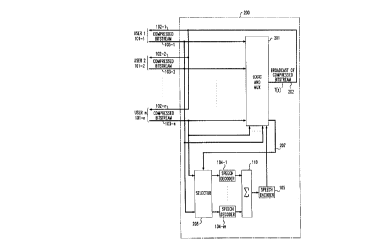Some of the information on this Web page has been provided by external sources. The Government of Canada is not responsible for the accuracy, reliability or currency of the information supplied by external sources. Users wishing to rely upon this information should consult directly with the source of the information. Content provided by external sources is not subject to official languages, privacy and accessibility requirements.
Any discrepancies in the text and image of the Claims and Abstract are due to differing posting times. Text of the Claims and Abstract are posted:
| (12) Patent: | (11) CA 2114868 |
|---|---|
| (54) English Title: | CONFERENCING ARRANGEMENT FOR COMPRESSED INFORMATION SIGNALS |
| (54) French Title: | DISPOSITIF DE PRISE EN CHARGE DE SIGNAUX DE CONFERENCE COMPRIMES |
| Status: | Deemed expired |
| (51) International Patent Classification (IPC): |
|
|---|---|
| (72) Inventors : |
|
| (73) Owners : |
|
| (71) Applicants : | |
| (74) Agent: | KIRBY EADES GALE BAKER |
| (74) Associate agent: | |
| (45) Issued: | 1997-12-23 |
| (22) Filed Date: | 1994-02-03 |
| (41) Open to Public Inspection: | 1994-09-25 |
| Examination requested: | 1994-02-03 |
| Availability of licence: | N/A |
| (25) Language of filing: | English |
| Patent Cooperation Treaty (PCT): | No |
|---|
| (30) Application Priority Data: | ||||||
|---|---|---|---|---|---|---|
|
-8-
A conferencing bridging technique for compressed information signals
which monitors the signal energy transmitted by each conferee. When there is only
one conferee speaking, the summing circuit in the bridge unit is bypassed along with
the speech decoding/coding apparatus and the talking conferee's signal is broadcast
to all conferees. If there is more than one conferee speaking at any given time, then
only the speaking conferee's signals are routed to an associated speech decoder
wherein those conferees' compressed signals are decompressed. These
decompressed signals are then combined by the summing circuit and the sum is
recompressed and broadcast to all conferees. Advantageously, the above-describedtechnique eliminates the signal degradation associated with tandeming of signal
decoding and coding operations and permits the sharing of a smaller number of
signal decoders among a larger number of conferees.
Technique de pont de conférence pour les signaux compressés d'information qui surveille l'énergie des signaux transmise par chaque participant. Si seulement un participant parle, le circuit de sommation du pont est contourné ainsi que l'appareil de codage/décodage des signaux vocaux et le signal du participant qui parle est diffusé à tous les participants. S'il y a plus d'un participant qui parle à un moment donné, alors seulement les signaux vocaux d'un des participants sont acheminés vers un décodeur correspondant de signaux vocaux où les signaux compressés du participant sont décompressés. Ces signaux compressés sont ensuite combinés par le circuit de sommation et la somme est compressée de nouveau et diffusée à tous les participants. Avantageusement, la technique décrite ci-dessus élimine la dégradation de signaux correspondant à la mise en tandem d'opérations de codage et de décodage de signaux et permet le partage d'un plus petit nombre de décodeurs entre un plus grand nombre de participants.
Note: Claims are shown in the official language in which they were submitted.
Note: Descriptions are shown in the official language in which they were submitted.

For a clearer understanding of the status of the application/patent presented on this page, the site Disclaimer , as well as the definitions for Patent , Administrative Status , Maintenance Fee and Payment History should be consulted.
| Title | Date |
|---|---|
| Forecasted Issue Date | 1997-12-23 |
| (22) Filed | 1994-02-03 |
| Examination Requested | 1994-02-03 |
| (41) Open to Public Inspection | 1994-09-25 |
| (45) Issued | 1997-12-23 |
| Deemed Expired | 2009-02-03 |
There is no abandonment history.
| Fee Type | Anniversary Year | Due Date | Amount Paid | Paid Date |
|---|---|---|---|---|
| Application Fee | $0.00 | 1994-02-03 | ||
| Registration of a document - section 124 | $0.00 | 1994-07-29 | ||
| Maintenance Fee - Application - New Act | 2 | 1996-02-05 | $100.00 | 1996-01-22 |
| Maintenance Fee - Application - New Act | 3 | 1997-02-03 | $100.00 | 1997-01-09 |
| Final Fee | $300.00 | 1997-09-12 | ||
| Maintenance Fee - Patent - New Act | 4 | 1998-02-03 | $100.00 | 1998-01-06 |
| Maintenance Fee - Patent - New Act | 5 | 1999-02-03 | $150.00 | 1998-12-21 |
| Maintenance Fee - Patent - New Act | 6 | 2000-02-03 | $150.00 | 1999-12-20 |
| Maintenance Fee - Patent - New Act | 7 | 2001-02-05 | $150.00 | 2000-12-14 |
| Maintenance Fee - Patent - New Act | 8 | 2002-02-04 | $150.00 | 2001-12-20 |
| Maintenance Fee - Patent - New Act | 9 | 2003-02-03 | $150.00 | 2002-12-18 |
| Maintenance Fee - Patent - New Act | 10 | 2004-02-03 | $250.00 | 2003-12-19 |
| Maintenance Fee - Patent - New Act | 11 | 2005-02-03 | $250.00 | 2005-01-06 |
| Maintenance Fee - Patent - New Act | 12 | 2006-02-03 | $250.00 | 2006-01-05 |
| Maintenance Fee - Patent - New Act | 13 | 2007-02-05 | $250.00 | 2007-01-08 |
Note: Records showing the ownership history in alphabetical order.
| Current Owners on Record |
|---|
| AMERICAN TELEPHONE AND TELEGRAPH COMPANY |
| Past Owners on Record |
|---|
| NAHUMI, DROR |